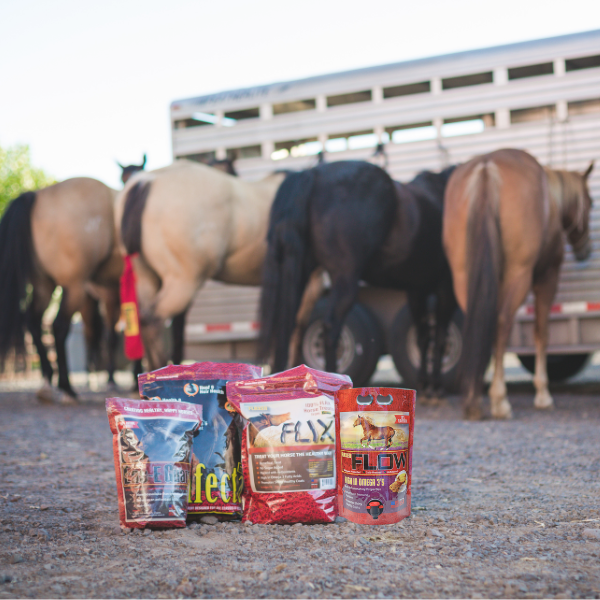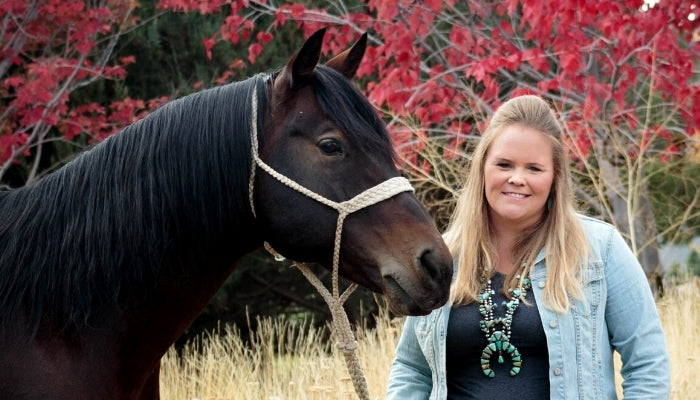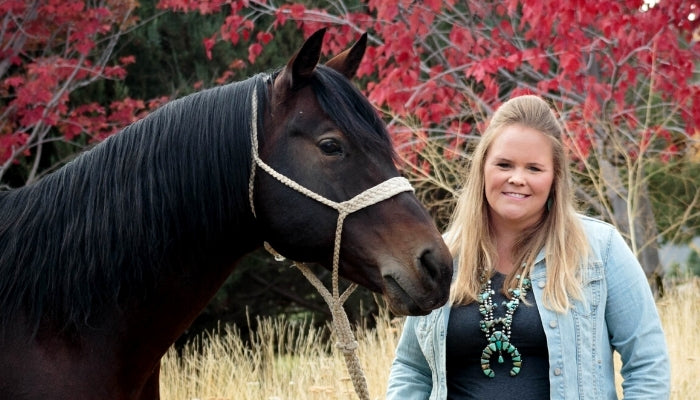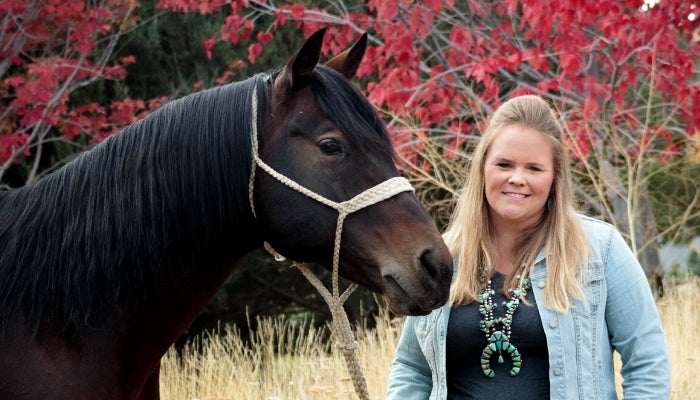- ▼I NEED TO ADD SOME JOINT SUPPORT TO MY FAVORITE HORSE GUARD?
-
Customer: “I have used your product for years but want to make sure I am doing right by the product I am using or do I need something else. I feed endurance horses, one is a hard keeper other not so much. I use the horse guard vitamin. What I was wondering is should I use another version in conjunction with the horse guard vitamin for these guys? I do not use joint supplements I feed fresh ground flax 4-8 ounces daily. free choice grass hay and 24/7 pasture.”
Answer by Ph.D. Equine Nutritionist, Kelsey Johnson Nonella: Thank you very much for your loyalty to Horse Guard. We truly believe we produce the best equine supplements on the market. Horse Guard is taking care of all your horses’ basic vitamin/mineral needs. However, if you want to consider a product that has a hoof supplement and joint supplement I would switch to Horse Guard’s Trifecta. It not only contains a full dose of Horse Guard, but also has a complete dose of our product Hoof Guard (32 mg of biotin, zinc, methionine, and MSM), probiotics and live yeast cultures for hindgut support, and a very powerful joint supplement (5000 mg of glucosamine and MSM, and 100 mg of hyaluronic acid). There has been a lot of research done that shows starting oral joint support before the onset of arthritis is more effective than treating after arthritis has developed. With your high-performance horses, I think this would be very beneficial for them. All 15 of our high-performance horses are on Trifecta, and it has helped maintain healthy joints in our older horses. - ◄HORSE GUARD DOSAGE FOR 1300 ANDALUSIAN
-
Customer: “I have an Andalusian gelding. He is 16.2 and I’m guessing he weighs 1300 lbs. I purchased Horse Guard, and your directions say 1 scoop per 500 lbs. the vitamins came with its own scoop. I think it’s 2oz, making it for a 1000 pound horse. I want to know how much to feed my big boy. Thank you for your response”
Answer by Ph.D. Equine Nutritionist, Kelsey Johnson Nonella: Your 1300 lb guy should get just short of 3 ounces. The enclosed cup holds 2 ounces by weight. You will feed just short of 1.5 cups. I hope this helps. - ◄WILL MY HORSE EAT HORSE GUARD?
-
Customer: “I’m very interested in trying horse guard supplement on my horses but after spending money on ones that don’t work or my horses won’t touch, I am having a hard time shelling out the cash. Do you guys have any free samples so at least I can make sure my horses will eat it?”
Answer by Ph.D. Equine Nutritionist, Dr. Kelsey Johnson Nonella: Thank you for considering our products. Hopefully, you love them as much as we do. Unfortunately, we don’t have any free samples. However, we do have 100% money-back guarantee. If you are not satisfied with the product, return it and we will refund 100% of your money. I hope this guarantee will encourage you to try our products. Thank you are taking good care of your horse. - ◄FEEDING HORSE GUARD AND RED CELL
-
Customer: “ I feed a full scoop of Horse Guard to my 15-year-old barrel horse mare daily. I was told to add 2 ounces of Red Cell to her daily bucket. However, I am concerned that I may be feeding too much selenium. She gets fed alfalfa twice daily, soaked beet pulp once a day, and a full scoop of Horse Guard with her bucket.”
Answer by Ph.D. Equine Nutritionist, Dr. Kelsey Johnson Nonella: Thank you very much for feeding your mare Horse Guard. She is getting everything that she needs with the alfalfa, beet pulp, and Horse Guard. Is there specific reason why you started adding Red Cell to her diet? Red Cell is another vitamin-mineral supplement that provides your horse an inorganic source of selenium. So, although you don’t need to worry about selenium toxicity you are having an unnecessary cost. - ◄OPTIMAL HORSE GUARD DOSAGE AND OTHER SUGGESTIONS TO SHINE HIS COAT UP FOR MY HEAVY, 1,250 LB HORSE
-
Customer: “My half draft is 1,250 pounds. He is currently getting: 5-6 flakes of local hay distributed throughout the day, 1 lb of Safe Choice, twice per day, and one scoop of Horse Guard. He is pretty fat on this regime, but his winter coat is dull and not shedding very fast in our 60-degree weather. I have only owned him since August of 2014 and have not seen his winter coat before. He does not have the symptoms of metabolic syndrome despite his weight. What is the optimal dose for Horse Guard?”
Answer from Ph.D. Equine Nutritionist, Dr. Kelsey Johnson Nonella: Sorry to hear about your horse. The optimal dose of Horse Guard for him would be 1 1/4 scoops. If he is chubbier than you would like I would recommend reducing the Safe Choice to just the amount that he will eat his Horse Guard. This will reduce his caloric intake, and help reduce his weight. Another option that you could consider is substituting the Safe Choice with Glow. Glow is extruded soybeans that would provide energy your horse energy from protein and fat, and also aid in helping to shine up his coat. - ◄NO LYSINE IN HORSE GUARD?
-
Customer: “Can you tell me why your Horse Guard contains no lysine?”
Answer from Equine Nutritionist, Del Johnson: Thank you for your inquiry. Lysine is an essential amino acid in humans and is important in young horses before their caecum is developed. Most nutritionists believe that after the caecum is developed they are capable of producing their own lysine in the caecum and lower intestinal tract. Even so, some nutritionists do recommend supplementation. It is important to note that unless the horse is on low-quality grass hay they will get plenty of lysine from forage. Alfalfa and soybeans contain high amounts of lysine. For horse owners that do wish to supplement additional lysine, we provide Super Weight Gain that not only provides lysine in the soybeans but has supplemental lysine. Super Weight Gain is fed at 8 ounces per day for a 1000 lb horse. Unless you are feeding low quality forage your horses will not benefit from Lysine supplementation. If you do need additional lysine I suggest that Super Weight Gain is an excellent source, which includes a full dose of Horse Guard. - ◄HOW MUCH SELENIUM IS IN HORSE GUARD AND WHY?
-
Customer: “How much Selenium is in Horse Guard and why?”
Answer from Equine Nutritionist, Del Johnson: All of our multi-vitamin/mineral products provide 3 mg. of organic selenium to a 1000 lb horse. Horse Guard provides it in a 2-ounce dose. Nutritional recommendations vary greatly no matter the element to which they refer. Most nutritionists are not from a selenium-deficient area and know little about the deficiency. We were the first company to provide an oral equine supplement for selenium in 1978. Selenium research was started at Oregon State University. Before that research, there was no recommendation for selenium. Dr. Stowe at the Michigan State University did original work with selenium in equines. His work included horses that were not being used or stressed. The NRC recommendations that followed were for 1 mg per day for a 1000 lb horse. After that time most recommendations by nutritionists were for 1 mg per day. Research in the early eighties showed that baby pigs under stress of weaning did much better on a diet of .3 ppm selenium. As a result of testing horses, we began recommending a higher level of selenium for horses under stress at 3 mg per day. As you know horses are typically under much more stress than farm production animals. Nutritional science really does not know enough about selenium metabolism. As a result, we are currently funding a selenium study at West Texas A&M. This work is being done by my daughter who is completing her Ph.D. work. The study takes selenium sufficient horses and puts them on a selenium-deficient diet with hay from Central Oregon. We monitor the depletion of selenium in the blood over time. That phase is complete. All of the horses were significantly deficient at day 112. We are currently in the repletion phase and are now monitoring the repletion by adding organic selenium to the diet with Horse Guard. The recommendation for Horse Guard is 1 ounce per 500 lbs body weight. That provides 2 ounces of Horse Guard per 1000 lbs. Two ounces of Horse Guard provides 3 mg of organic selenium per 1000 lb horse per day. The toxic level of selenium is above 20 mg per day. You would have to feed almost 8 times the recommended dose of Horse Guard each day to reach toxicity. I hope this helps. I apologize for the length of the response but we take great pride in our leadership in equine nutrition especially when it comes to selenium. - ◄CONCERNS ABOUT IRON IN HORSE GUARD
-
Customer: “I am looking at changing from Millennium Gold to Horse Guard and my questions is that being in Ellensburg, specifically that we do not need iron in any of the vitamin and mineral products because there is already so much iron in not only the ground but through the grass and the hay has a lot of iron. This comes from the fact that we are located on basalt and the basalt has the iron that has transfered to the ground, then to the grass and hay. Thank you.”
Answer by Ph.D. Equine Nutritionist, Dr. Kelsey Johnson Nonella: I think Horse Guard would benefit your horse greatly. There is a low level of Iron in Horse Guard, and the threshold of Iron before toxicity is very high. Therefore, you should have no trouble feeding Horse Guard. Please note that Millennium Gold does not have 100% organic selenium and only has 1 mg of selenium. Throughout the northwest our horses require 3 mg of selenium, preferably organic selenium which is much safer and effective than inorganic selenium. Also our products are made from all natural preservatives, unlike Millennium Gold. - ◄AM I FEEDING THE RIGHT STUFF?
- Customer: “I am feeding horse guard right now to my 2 senior horses (20 and 24 yr old) and my 12yr molly mule. They are getting 3 way and a little alfalfa morning and night in a slow feeder. I give them Horse Guard and a little Intergity no molassas in the evening. They are ridden almost everyday only on trail rides up & down steep hills, anywhere from 3 to 6 hours. I worry about the selenium, that they are not getting enough or getting to much. or if I need to give them something else. I live in Benton, California where the selenium is very low. I just hope that I am doing the right thing for them. Let me know what you think. Thanks so much.” Answer by Ph.D. Equine Nutritionist, Kelsey Johnson Nonella: It sounds like you are taking amazing care of your horses. It sounds as though their diet is very suited for their workload as well as the area you are located in. When feeding them their daily dose of Horse Guard, they are receiving 3 mg of organic selenium, which is higher than other products on the market because it is designed for areas that are low in selenium. Research has shown that 3 mg of organic selenium increases immune function, and muscle function and recovery as compared to horses fed 1 mg organic selenium. You are doing a great job of ensuring the good overall health for your horses with great nutrition.
- ◄FEEDING MULTIPLE SUPPLEMENTS TOGETHER?
-
Customer: “I am already feeding horse guard and hoof and hair guard. i am just wondering about starting on the joint guard in addition to these. but i am wondering if they will get too much of something if i add this supplement can you give me some advice?”
Answer by Ph.D. Equine Nutritionist, Kelsey Johnson Nonella: Great to hear you are taking great care of your horse. You are perfectly fine to feed a joint supplement in addition to Horse Guard and Hoof and Hair Guard. However, you may consider replacing Horse Guard, Hoof and Hair Guard, and an additional joint supplement with Trifecta. Trifecta not only has a full dose of Horse Guard; it has a hoof supplement (32 mg of biotin, zinc, methionine, and MSM), gut support (prebiotics, probiotics, and live yeast cultures), and powerful joint supplement (5000 mg glucosamine, 5000 mg MSM, and 100 mg hyaluronic acid). Trifecta is an amazing product that helps to simplify feeding. In 2 scoops (8 oz) a day to a 1000 lb horse, your horse gets all of this support. We have fifteen head of performance horses ourselves that all receive Trifecta and do absolutely amazing on it. - ◄CAN I SOAK HORSE GUARD PELLETS?
-
Customer: “Can I soak Horse Guard pellets with my beet pulp without ruining the vitamins and minerals?”
Answer by Ph.D. Equine Nutritionist, Kelsey Johnson Nonella: You can soak the Horse Guard pellets as long as you use soak them for no more than 30 minutes. If they are soaked longer the vitamins will start to degrade. - ◄WHAT DO I NEED TO FEED MY PREGNANT MARE
-
Customer:“I have a 14-year-old Swedish WB mare who is currently 8 1/2 months pregnant with her second foal. She is 16.1 and easily 1,350 lb (while not pregnant). She is a VERY easy keeper and I want to avoid sugars and starches in her diet as much as possible. Currently, she is fed 10 lb grass hay, 10lbs alfalfa, 1 lb of haystack, and 1 lb of oats per day. I’m looking for a supplement that will meet all of her nutritional requirements for her third trimester without adding any additional grain to her diet (although I may need to increase her haystack over the next few months). What supplement do you recommend for her and in what quantity as she reaches her final phase of gestation?”
Answer by Ph.D. Equine Nutritionist, Kelsey Johnson Nonella: One very important nutritional aspect in a pregnant and nursing mare’s is calcium: phosphorous ratio, which should be 2:1. By feeding your mare half grass, half alfalfa you are good on the Ca:P ratio. One thing that is very important to add as soon as possible is organic selenium. At her weight, she needs 4.5 mg of organic selenium. She will receive this from 1 1/2 scoops (3 oz) of Horse Guard. At such a low dose, it won’t add any substantial amount of calories to her diet. I would recommend keeping her on the supplement on the time, but especially during nursing and if you are going to breed her again. Mares that are selenium deficient have greater chance of retained placenta and complications with birth, and foal health problems. It takes a selenium-deficient horse approximately 8 months to reach adequate levels. - ◄RESULTS WITH RESCUE HORSE, WHAT NEXT FOR HIM
-
Customer: “I am currently feeding my horse Super Weight Gain. I am very pleased with his weight gain. He is looking good and is almost at an ideal weight. Could you please give me the approximate number of kilocalories per pound (or a similar unit) for this product and the protein and fat content? Thank you.”
Answer by Ph.D. Equine Nutritionist, Kelsey Johnson Nonella: Great to hear Super Weight Gain has helped your horse out. In 8 ounces of Super Weight Gain there are 1250 kcal. The product is 35% crude protein, and 15% crude fat. What really benefits horses in poor condition is that multiple issues are addressed in Super Weight Gain. So in addition to high fat and protein levels, the probiotics help to stabilize the gut so that your horse can get the most out the feed he is consuming, and the vitamin and mineral pack addresses any deficiencies. So when he gets to the weight you would like make sure to keep him on a vitamin-mineral supplement, like Horse Guard. With the help of Super Weight Gain a lot of horses are able to just be supplemented with Horse Guard and fed a high-quality forage (and maybe some concentrate) after reaching their ideal weight. However, some horses are just hard keepers and need to remain on Super Weight Gain to maintain their weight. So, just keep an eye on your horse and you can determine what is best for him. - ◄CRUDE PROTEIN IN HORSE GUARD
-
Customer: “Could you please tell me the amounts of crude protein, fat, and fiber in Horse Guard?”
Answer by Ph.D. Equine Nutritionist, Kelsey Johnson Nonella: A 2-ounce dose of Horse Guard is 12% Crude Protein, 3.5% Crude Fat, and 10% Crude Fiber. It is important to remember, however, when considering the whole diet of a horse that 2 ounces is a very small amount. So, when formulating a ration the crude protein, fat, and fiber are minute amounts and will hardly affect the protein, fat, and fiber levels of the total ration. - ◄IS MY HORSE GETTING ENOUGH AMINO ACIDS
-
Customer: “Hello, I feed my 3 horse and mini oats, Cocosoya oil, and Horse Guard. I’m wondering if the Horse Guard has a sufficient amount of amino acids in it? ”
Answer by Ph.D. Equine Nutritionist, Kelsey Johnson Nonella: When fed high-quality hay with the oats, oil, and Horse Guard, your horses are receiving sufficient amino acids. There are only few times that you would have to worry about insufficient amounts of amino acids. A young horse or skinny horse on low-quality forage would be most likely lysine deficient. - ◄MAGNESIUM IN HORSE GUARD
-
Customer: “Hello, can you tell me how many grams are in Horse Guard? It only gives mg. I want to make sure my horses are getting enough magnesium.”
Answer by Ph.D. Equine Nutritionist, Kelsey Johnson Nonella: Your horse is getting 0.175 grams of magnesium is his 2 ounce dose of Horse Guard. The average horse needs to consume 10 grams of magnesium a day. Magnesium is a macro mineral and therefore is consumed in amounts higher than can be provided in a 2 ounce dose. Feeds that are high in magnesium are alfalfa and flaxseed. I would recommend getting your hay analyzed in order to determine your horse’s daily consumption of magnesium. Also, keep in mind that it is very important that your horse’s calcium consumption is about twice that of his magnesium consumption. - ◄WHAT TO FEED WITH HORSE GUARD
-
Customer: “I just ordered your product, Horse Guard, per recommendation from my vet. My horse is a 16-year old in moderate work, fed a grass/alfalfa mix twice daily, a hay local to us here in Utah. He does not have access to field/grass turnout or any additional forage. He is of good weight, and has a healthy coat and hooves, but like many horse owners, I felt like he might be missing key nutrients in his diet. I noticed the feeding advice for this particular supplement is to feed on top of some kind of grain. What is your recommendation? I used to feed a ration balancer when I lived out of state, but I feel like those are formulated with their own slew of vitamins/minerals, so I don’t know if I would go down that road or not, especially since the feeding volume for a horse like him is well over a pound a day AND because this product already contains nutrients lacking in our region. Also, I do think my horse would be more excited to take his “vitamins if he had something to mix in with them. Thank you for reading!”
Answer by Ph.D. Equine Nutritionist, Kelsey Johnson Nonella: Thank you for the questions. I think you will love Horse Guard. First off, we recommend top dressing the supplement on a little bit of grain simply for palatability reasons. There are no added fillers to the product so it has much the taste of a multi-vitamin. With that being said, I have many horses who happily eat it out of my hand with nothing added it or just put on their hay. If your gelding eats it without anything added or on top of his hay that’s great and you don’t need to add anything. However, if your horse isn’t so sure about it you can mix it with just enough concentrate (I have great luck with just a handful of rolled oats or wet cobb). There is no need to feed a ration balancer because like you said, he’s getting his vitamins and minerals from Horse. - ◄HORSE GUARD WITH HIGH MAGNESIUM SALT
-
Customer: “I have been giving my gelding a loose salt product containing hi mag, it claims to be for the IR horse. I use Horse Guard. I don’t know how much magnesium is the correct percentage to give and if I need the loose salt with the hi mag or is Horse Guard enough? Don’t want to double dose. At your convenience, I would love to hear your advice.”
Answer by Ph.D. Equine Nutritionist, Kelsey Johnson Nonella: Thank you for the question. The addition of the loose salt with magnesium is perfectly safe, and good for your horse that is IR. Horse Guard contains 1.2 g of magnesium. Your horse requires 10 g per day. He is receiving most of his magnesium from the hay and concentrates you are feeding him. I don’t know how much your salt contains, but products designed for calming contain 5 g of magnesium and pair great with Horse Guard. - ◄FEEDING HORSE GUARD TO MY FOAL
-
Customer: “At what age foal can you start feeding Horse Guard?”
Answer by Ph.D. Equine Nutritionist, Kelsey Johnson Nonella: If the mare is receiving Horse Guard I would start the foal when you wean the foal because he is getting selenium from his mother’s milk. However, if the mare is deficient or it is an orphan foal you can supplement them right right away. Just feed the dose according to his weight. For example, if you estimate he weighs 250 when you wean him feed a 1/4 of a scoop. - ◄IS 2 OUNCES A DAY WHAT I SHOULD BEING SUPPLEMENTING?
-
Customer: “I’m in Enumclaw WA and was wondering what dosage I should feed my horses with Horse Guard? I feed Timothy and Orchard grass hay from Eastern WA and they don’t graze much. I feed Hay Stack blend and supplement with Horse Guard and Flax. Is 2 oz a day the amount I should feed daily?”
Answer by Ph.D. Equine Nutritionist, Kelsey Johnson Nonella: The dosage of Horse Guard depends on the weight of your horses. The daily dose of Horse Guard is 2 oz per 1000 lb (average weight of a horse). So if your horse is around the average weight you can feed one scoop to each horse every day. - ◄POTASSIUM IN HORSE GUARD
-
Customer: “I was wondering what the Potassium % is per feeding?”
Answer by Ph.D. Equine Nutritionist, Kelsey Johnson Nonella: We do not add any potassium to our products in order to ensure it is safe for HYPP horses. - ◄HORSE GUARD DAILY
-
Customer: “I was wondering why my horse needs to eat Horse Guard daily?”
Answer by Ph.D. Equine Nutritionist, Kelsey Johnson Nonella: Your horse needs Horse Guard daily in order to meet his vitamin-mineral requirements. It is just like humans taking a one-a-day vitamin, however, much more important for your horse because they don’t get the variety in their diet that we do. - ◄EATING LESS ON HORSE GUARD
-
Customer: “I started horse guard on my almost 15-year-old QH 3 weeks ago. Since then he’s not eating g as much hay. He has had a vet check-up and teeth were good. His demeanor and weight are good also. My question is, do you think he’s getting more of what he needed through horse guard, so he’s not eating as much? ”
Answer by Ph.D. Equine Nutritionist, Kelsey Johnson Nonella: It is great that you started your horse on Horse Guard. It will help to meet all his nutritional needs that aren’t met by the hay. The vitamin/mineral supplement must likely isn’t causing the reduction in the amount of hay he is eating. Interesting note, salt to the only micronutrient that horses self-regulate, meaning it is the only micronutrient they will seek out if they are deficient. Horses typically consume between 1-2% of their body weight in hay per day. Amounts can vary to due to several factors. For example, if it has warmed up the horse doesn’t need as much energy and will decrease to amount of hay he consumes. As long as your horse’s hay consumption is staying above 1% you should have no need to be concerned. It sounds like you monitor your horse’s feed consumption and body condition very carefully. So just keep an eye on him to make sure is stays in good condition. Your horse will thank you for having to best health in mind. - ◄HORSE GUARD FOR A FOUNDERED HORSE?
-
Customer: “I was wondering if you could help me decide which feed to put him on,I believe he is foundering and would like to know what I should give him besides his Bermuda hay, we in Arizona & he is not on irrigation, no pasture now. I been feeding a Purina senior. Thanks for your help, there’s a tractor supply here and would like your opinion, thanks so much.”
Answer by Ph.D. Equine Nutritionist, Kelsey Johnson Nonella: Sorry to hear about your horse. I would recommend continuing to feed your horse Bermuda (which is a great hay for laminitic horses because it is lower in non-structural carbohydrates). If your horse is on the heavier side I would recommend removing the Purina Senior, and just feed him a dose of Horse Guard to ensure his vitamin and mineral requirements are being met. If your horse is in good body condition, remove the senior feed, and give him a dose of Horse Guard with all the Bermuda hay he can eat. If you want to give your horse some concentrate give him just enough to get him to eat the supplement look for a concentrate that low in carbohydrates. Hope this helps. - ◄FEEDING HORSE GUARD AND BIOTIN HOOF BLAST
-
Customer: “Is it ok to feed horse guard and biotin hoof blast together on a long term basis? Thank you!”
Answer by Ph.D. Equine Nutritionist, Kelsey Johnson Nonella: Yes, it is perfectly fine to feed Horse Guard and Biotin Hoof Blast together on a long term basis. - ◄IS MY HORSE GETTING EVERYTHING HE NEEDS?
-
Customer: “I’ve been using the standard horse guard, with success, my question is there any other trace minerals that I need to give my horse other than salt?”
Answer by Ph.D. Equine Nutritionist, Kelsey Johnson Nonella: Great to hear your horse is doing well on Horse Guard. Giving your horse access to a plain white salt block and feeding him Horse Guard with a good quality hay (and a concentrate if you choose) will take care of all your horse’s needs. No need to supplement your horse with any other trace minerals. - ◄HORSE GUARD WITH MAGNESIUM SUPPLEMENT?
-
Customer: “I recently started feeding your HG vitamins to my seven Fjords. Even the pickiest Fjord loves them! One of the Fjords is on a Magnesium supplement for a somewhat cresty neck. Is that okay to feed with your product? I don’t want to over supplement. Thanks!”
Answer by Ph.D. Equine Nutritionist, Kelsey Johnson Nonella: That’s great to hear that your Fjords love Horse Guard. We love it when they like something that is healthy for them. You can feed your Magnesium supplement with the Horse Guard and be assured that it is safe. - ◄VITAMIN E IN HORSE GUARD
-
Customer: “Hello, On packaging it says per pound…..can I get the Vitamin E IU per serving and what type of source the vitamin E is? Also, possible to get the entire analysis per serving? I use 2oz per horse. I absolutely love your product and have used it for years. Used to use it in Oregon when I lived there and couldn’t get on shelves here in Utah, but was super happy when CAL Ranch started carrying it! I have a deficient horse and need to know per servings. Thank you for your help.”
Answer by Ph.D. Equine Nutritionist, Kelsey Johnson Nonella: Thank you for the question and comments. We love to hear when customers love our products as much as we do! We are a family-owned business that takes great pride in our products. In Horse Guard, there is 1,500 IU of synthetic Vitamin E per 2 oz. Due to regulations, we have to label nutrients per pound but you can easily calculated the mg or IU per 2 oz by the dividing the per by 8. I hope this helps. Let me know if I can answer any more questions for you. Thank you for being such a loyal customer!
Hello, I feed my two mares (17 and 24) 2 oz of Horse Guard daily along with flax seed and also have a free choice mineral supplement block available to them. Is this too much? Should it be just a salt block?
Thank you.






Kelsey Nonella, PhD, PAS
August 25, 2021
Sonya,
Thank you for the question. While you aren’t going to get toxic levels next time you get a new block I would just buy a plain white salt block.
Let me know if I can answer any more questions.